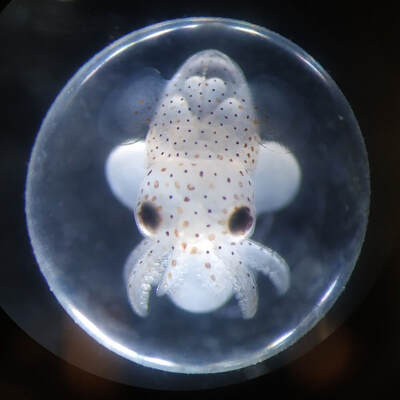Education
Mathieu graduated with a Master’s Degree in Marine Ecology and Organismal Biology at the University of Côte d'Azur, France. As a requirement for their graduation, they did a 5-month internship in the Edsinger Lab at the Marine Biological Laboratory, USA, working on the development of genetic tools in Pygmy Squid (Idiosepius paradoxus). Now, they are a PhD student at the Max Planck Institute for Brain Research, Germany, in Laurent Department, which focuses on the behaviour, dynamics and emergent properties of neural systems.
The Cephalopod Model
|
Cephalopods are a group of animals including squids, octopuses and cuttlefish. While they evolved camera-like eyes, a closed cardiovascular system and complex brain and behavior, our last common ancestor, which lived roughly 600 million years ago, did not have those features. This evolutionary convergence makes cephalopods an ideal comparative model to vertebrates for investigating the emergence of these complex systems.
Cephalopods also evolved fascinating traits, such as three hearts, blue blood, chemosensitive arms, an extensive nervous system distributed across all the body, unmatched camouflage, impressive regenerative capabilities, as well as RNA editing. These incredible animals might be the most alien-like intelligent lifeform we'll ever get to meet and study. |
Development of the Chromatophores Motor Control System
|
Cephalopods can change color and shape in a fraction of a second. They achieve this extraordinary visual trick by using a set of organs located in their skin, including chromatophores. A chromatophores is composed of a pigment sac at its center and a collection of radial muscles around it. These radial muscles are innervated by motoneurons which connect them directly to the brain. The skin of a cephalopod can contain millions of chromatophores. These can have different color and together they can form patterns, similarly to pixels on a screen.
Chromatophores are not innervated uniformly. In fact, a single motoneuron can innervate a collection of radial muscles belonging to several chromatophores, which will expand and contract in tandem. A motoreuron and the chromatophores it innervates form a so-called motor unit. As the animal grows, new chromatophores are generated. Chromatophores of the same age-class form a chronological unit. |
The goal of Mathieu's project is to study the development of the motor control system of chromatophores in Euprymna berryi and Sepia officinalis. The biological questions they plan to answer are:
- How are motor units structured and arranged?
- How do motor units change over time with the addition of chronological units?

